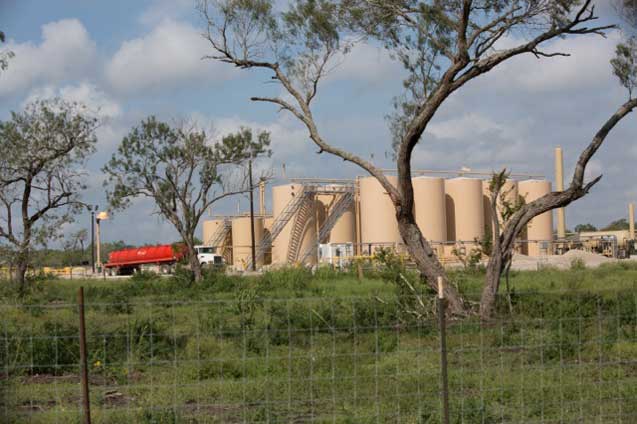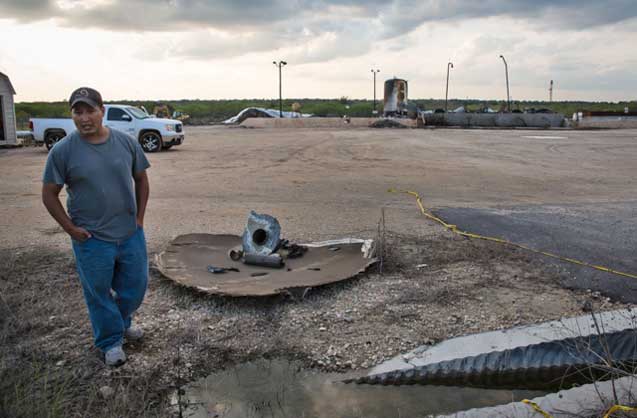
Part of the Series
Gas Rush: Fracking in Depth
Did you know that Truthout is a nonprofit and independently funded by readers like you? If you value what we do, please support our work with a donation.
Fracking is in full swing in the Eagle Ford Shale region of southern Texas, home to the most productive oil field in the United States.
For Cynthia Dupnik, whose Karnes County home is in the center of the region, life is no longer serene. At night, she says the landscape is frighteningly apocalyptic, marked by the roaring flares spreading pollutants across the sky from oil and gas operations.
The first time Dupnik heard about fracking was when Marathon Oil Corporation started drilling near her home. After complaining that she was getting sick, Marathon sent a team to take air samples on her property, but never returned with the test results.
Dupnik is also concerned about a nearby Marathon Challenger tank battery, a facility used in shale production, which almost constantly has a flare emitting toxic fumes into the air only six-tenths of a mile from Dupnik’s home. Some nights the flare from the tank battery site is so bright she can see it from her front porch.
On the evening of December 13, Dupnik says the noise coming from the tank battery site was louder than usual and the air smelled like rotten eggs. She experienced a metallic taste in her mouth and had a hard time breathing so she called the Texas Commission on Environmental Quality (TCEQ). No one picked up, so she called the sheriff’s office, which sent a deputy over. The deputy told Dupnik the noise and smell were not out of the ordinary, but called the Texas Railroad Commission which assured Dupnik they would let the Texas Commission on Environmental Quality know.
Dupnik had already lodged a complaint about the tanker battery site with the commission in July 2013, and was assured test results were forthcoming. Despite repeated followup, Dupnik says she’s been unable to get any information about the test results.
 Shale production facility in Karnes County. (Photo: ©2013 Julie Dermansky)
Shale production facility in Karnes County. (Photo: ©2013 Julie Dermansky)
Even without those results, Dupnik believes that whatever the new industrial facilities are emitting into the air can’t be good. Before the drilling started, she says her family had no health issues but now they suffer from fatigue, headaches, rashes, eyestrain, sore throats, dizziness, nosebleeds and respiratory problems. Her doctor has given her an inhaler and antibiotics to clear up subsequent lung infections.
In her plight to find out more about what is happening to her family, Dupnik attended a meeting held by the environmental group Earthworks in September. Hydrogen sulfide, methanol, formaldehyde and benzene were just a few of the potentially cancer-causing chemicals environmental scientist Wilma Subra listed that can be emitted from drilling sites and facilities used to harvest oil and gas.
 Flare at a shale production facility in Karnes County. (Photo: ©2013 Julie Dermansky)
Flare at a shale production facility in Karnes County. (Photo: ©2013 Julie Dermansky)
When DeSmogBlog followed up with the Texas Commission on Environmental Quality on December 17, spokesperson Andrea Marrow confirmed by email that investigators made three visits to the Marathon tank battery facility between August 1 and October 10, 2013. But because the investigation is still open, she could not provide any more information.
When asked what the commission’s investigators would do if they found a facility emitting enough pollution to merit evacuation, Marrow wrote, “If there were an emergency situation, the TCEQ would work with local law enforcement, emergency responders and facility managers to notify residents as to what actions to take.”
However, in Earthworks’ report, “Reckless Endangerment while Fracking the Eagle Ford Shale,” documents obtained from a Freedom of Information Act request indicate otherwise. On March 1, 2012, the commission responded to a complaint made by the Cerny family (also Karnes County residents) about Marathon’s Sugarhorn Central facility, and evacuated the area to prevent exposure — yet the investigators didn’t warn the Cernys, even though they live less than a mile away.
Earthworks took air samples and used an infrared camera, which makes the release of methane and other volatile organic compounds visible. They concluded:
“Evidence from TCEQ and Earthworks/ShaleTest investigations indicate that air pollution from oil and gas development in the Eagle Ford Shale definitely threatens, and likely harms, the health of Karnes County Texas residents including the Cerny family. Despite these findings, no action has been taken by regulators to rein in the irresponsible operations, or otherwise protect area residents.”
The Eagle Ford Shale region has transitioned rapidly from pastoral to industrial over the last two years with few regulatory roadblocks.
Karnes Country now has frack ponds, drill sites, tank battery and saltwater treatment facilities and wastewater injection wells for disposing contaminated water. There are short-term housing units, called “man camps,” for the workers and a steady flow of 18-wheelers on the local two-lane highways.
 “Man Camp” in Karnes County. (Photo: ©2013 Julie Dermansky)
“Man Camp” in Karnes County. (Photo: ©2013 Julie Dermansky)
Some property owners are making money from royalties paid out for recovered oil after leasing their mineral rights. Others are making money selling water to the fracking industry, which requires millions of gallons to frack each well.
But many have been left out of the boom, and there’s a feeling of regret that things have changed so quickly.
Karnes County resident Radela Salinas, who has owned a home in Kenedy for 45 years, now sometimes goes back inside after stepping out, deciding the air is too bad to be outside.
Others are wary after a saltwater disposal plant exploded across the street from a residence in nearby Gillett in October, leveling the facility, injuring a worker and spreading toxic fumes over the city. Area roads now have a seemingly constant stream of 18-wheelers. This truck traffic creates its own air pollution threats, as well as increasing the number of fatal traffic accidents, as reported in the 2013 Texas Public Safety Threat Overview.
 Industry near homes in Kenedy, Texas. (Photo: ©2013 Julie Dermansky)
Industry near homes in Kenedy, Texas. (Photo: ©2013 Julie Dermansky)
Chris Green, who recently moved away from the area, says, “Driving anywhere around here, you put your life at risk.”
Green began driving more cautiously, giving up the right of way, whether it was his or not, in order to avoid the 18-wheelers. He sees nothing good about the changes happening in his hometown and is glad he moved away, he says.
 Worker standing guard at the remains of saltwater disposal plant that exploded. (Photo: ©2013 Julie Dermansky)
Worker standing guard at the remains of saltwater disposal plant that exploded. (Photo: ©2013 Julie Dermansky)
At long last, Dupnik got the results of the commission’s investigation on December 21. The inspector noted three violations at the tank battery site, which — according to Marathon — were non-reportable emission events. The commission gave Marathon until January 24 to take corrective actions.
Since the inspector didn’t smell any odors on Dupnik’s property and a portable monitor didn’t detect any chemicals, the investigator opted not to use the Summa canisters she had with her. The canisters collect air samples over a period of days and provide an accurate analysis of the air.
Dupnik was dumbfounded by the report. “I told the investigator conditions are much worse at night and that the smell isn’t always present,” she said.
The investigator recommended closing the file on Dupnik’s complaint since she could not confirm the problem.
Without an air analysis, the investigation is inconclusive. But the commission’s spokesperson, Marrow, wrote, “If there were an immediate threat to health, residents would be alerted.”
The question is: when inspectors go by what they smell and what can be monitored in the air days after a claim is made, rather than long-term air testing, how can homeowners know if they’re safe?
Environmental scientist Wilma Subra told DeSmogBlog, “The facilities in the various phases that are required for drilling production of crude oil and natural gas in the Eagle Ford Shale, and the emissions being released by these facilities, have the potential to cause severe health impact to the communities surrounding them.”
Residents like Dupnik are left to figure out if she should risk her family’s health, or stay and be part of an unofficial case study on the health problems of those living in a gasland.
 Frack Pond in Karnes County. (Photo: ©2013 Julie Dermansky)
Frack Pond in Karnes County. (Photo: ©2013 Julie Dermansky)
Matching Opportunity Extended: Please support Truthout today!
Our end-of-year fundraiser is over, but our donation matching opportunity has been extended! All donations to Truthout will be matched dollar for dollar for a limited time.
Your one-time gift today will be matched immediately. Your monthly donation will be matched for the whole first year, doubling your impact.
This matching gift comes at a critical time. As Trump attempts to silence dissenting voices and oppositional nonprofits, reader support is our best defense against the right-wing agenda.
Help Truthout confront Trump’s fascism in 2026, and have your donation matched now!